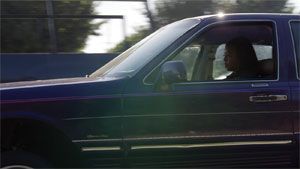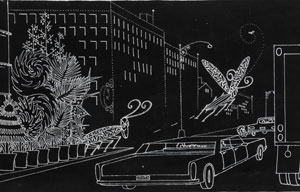4.17.24 — The Poetry of LA
Cauleen Smith could have even a New Yorker nostalgic for Southern California. That may sound like a tall order, although the sensation may last all of fifteen minutes, but Smith will make you feel right at home, recently at 52 Walker. And I work this together with a recent report on immersive video by Mary Lucier as a longer review and my latest upload. Smith, too, shows how a multichannel video can and cannot encompass a life, but will one fall for the illusion or pierce it? Is this really the video of a lifetime?
Smith sets out plush sofas—so comfortable that you may get up only to be sure that you have caught all four of the installation’s projections. Throw rugs can hardly cover the upscale Tribeca gallery (aka David Zwirner), but then what could? Besides, you know what people say: everyone out there is famous for fifteen minutes. 
That includes Wanda Coleman, and Smith, who appeared in the 2017 Whitney Biennial, is out to extend the late poet’s moments of fame. The filmmaker is nostalgic not just for the city of her childhood, to which she has at long last returned, but also for a black woman who loved music almost as much as words. This is The Wanda Coleman Songbook, through March 16 (and apologieas for the late post while I catch up a bit), and you get to play DJ. You will just have to trust the gallery that Coleman, who died in 2013, earned a reputation as the poet laureate of Los Angeles. Her name may not mean much to a New Yorker, but then neither might this view of the great city without a city. This is LA as itself poetry but oddly remote from life.
Smith, who is African American, does not quite efface the urban core that many blacks call home, but she does relax and enjoy it. She treats the film’s multiple channels as an immersive experience. Two projections cover the facing long walls, the other two the alcoves to either side. Besides the sofas and rugs, she includes a coffee table for Coleman’s books and a quaint countertop with a good old turntable, where the songbook in question plays along. Smith commissioned music for the five tracks of an EP. Now she invites visitors to place the needle and to listen.
An EP may seem like a letdown or a rarity for those nostalgic for LPs, but this one is itself art. It comes in pink vinyl with splotches of bright red. I am tempted to say blood red, but in the installation’s spirit it might be better to think of candy canes and melted strawberry ice cream. Coleman also went by the name LA Blueswoman, but only some of the tracks are bluesy. All are as close to background music as the projection. It could be a direct retort to the California of Ed Ruscha.
 Where Ruscha goes heavy on irony and detachment, Smith is sincere and totally involved. Where he photographed Every Building on the Sunset Strip, she is seemingly random but also selective. She cuts among sunsets, palms, utility poles and a railroad crossing, where she waits like anyone else for a train to pass before she can move on. The building on the far side has its share of graffiti, but she does not see it as defacement. Even the region’s bane, traffic, looks charming from overhead on a highway at night. Segments may rush past, but they feel slower and longer, like those proverbial fifteen minutes of fame. Poverty and luxury alike are nowhere in sight.
Where Ruscha goes heavy on irony and detachment, Smith is sincere and totally involved. Where he photographed Every Building on the Sunset Strip, she is seemingly random but also selective. She cuts among sunsets, palms, utility poles and a railroad crossing, where she waits like anyone else for a train to pass before she can move on. The building on the far side has its share of graffiti, but she does not see it as defacement. Even the region’s bane, traffic, looks charming from overhead on a highway at night. Segments may rush past, but they feel slower and longer, like those proverbial fifteen minutes of fame. Poverty and luxury alike are nowhere in sight.
So much else is surely missing, not least the poetry. Coleman’s words appear on-screen now and then, but difficult to read, and aloud on vinyl, but just as difficult to hear. Is there a dark side? Three cut-outs leave their silhouettes on the walls, as more utilities and a creepy mask. Still, in a fourth projection, outstretched fingers like an ILY (I Love You) sign spell LA. As you head off to the gallery scene, downtown restaurants, and an overcrowded Canal Street, that sign-off, too, will soon be gone.
Read more, now in a feature-length article on this site.





